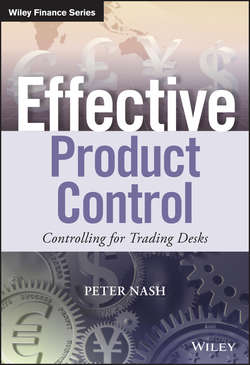Читать книгу Effective Product Control - Nash Peter - Страница 11
На сайте Литреса книга снята с продажи.
Part 1
Working in Product Control
CHAPTER 1
An Introduction to Product Control
Different Types of Product Control
ОглавлениеBefore we can explore the role of product control further we need to be aware that not every organization will share the same mandate for their product control function. Although there will be exceptions to this, we can broadly categorize the function into one of two types:
1. P&L only
2. P&L, balance sheet and financial reporting.
P&L Only
The P&L-focused role is, as its name suggests, focused purely on the P&L. In firms across the industry this function may also be labelled as middle office. The review and substantiation of the balance sheet and financial reports are performed by a separate team(s) within finance.
There are benefits and drawbacks for any organizational structure. There are two main benefits to this model. First, it relies on a team with a narrower skill set, which can improve the control framework as the product controller does not have to be an expert in an excessive number of disciplines (accounting, risk management, financial reporting, etc.). Second, as the skill set is narrower it should be easier for the firm to hire and develop their talent.
The primary but manageable drawback to this structure is that a single team is not controlling all the financial aspects of the desk and weakness in the control framework arises when the roles and responsibilities of the different finance teams are not clearly defined and understood by all staff.
For example, the product controllers for the credit trading desk are aware of a late trade booking for 31 December (financial year end) that has missed the end of day report batches that are used to populate the P&L reporting system and general ledger (GL) for financial reporting. The product controller determines the trade has an immaterial impact on the P&L so decides not to adjust the P&L.
Although the trade had an immaterial impact on the P&L, it had a material impact on balance sheet usage, which the financial controllers will not be aware of. Consequently, the firm's year-end reporting misstates not only the balance sheet size and shape, but also the capital ratios, as the risk-weighted assets (RWAs) did not take this late trade into consideration.
This drawback can be compensated for by having clear roles and responsibilities and up-to-date standard operating procedures (SOPs) for each function. These documents make clear the control framework which the firm has in place for each desk.
Each task and responsibility should be documented extensively and refer to what is a control exception and when that exception should be escalated. In this example, the SOPs could require product control to adjust the month-end financials (both P&L and balance sheet) for every late trade.
P&L: Balance Sheet and Financial Reporting Focus
A broader version of product control includes responsibilities which cover the P&L, balance sheet and some financial reporting for the bank.
This product controller is aware that changes in the balance sheet are the driver of P&L performance and as such it is critical that the balance sheet is reviewed, substantiated and understood.
This product controller will perform the same functions as the P&L-only controller in addition to the following tasks:
• Review and substantiation of the balance sheet
• Advising the desk on the accounting treatment for their transactions (if further expertise is not required from accounting policy)
• Assisting financial reporting in their review of the financial reports, including note disclosures
• Populating the GL with any necessary financial accounting entries.
As product control cover a substantial portion of the control framework assigned to finance, the bank benefits from a single team monitoring all aspects of the desk's financial performance (i.e., the P&L, balance sheet and financial reporting). This set-up should ensure both the P&L and balance sheet are aligned and that by seeing the full financial picture, issues are more readily identifiable.
The main drawbacks of this structure relate to the breadth of responsibilities being undertaken. As the product controller needs to be skilled in many more disciplines than the P&L-only function, it can be more difficult to recruit and develop talent. Additionally, so many responsibilities may cause some to be neglected.
As before, these drawbacks can also be compensated for by having clear roles and responsibilities and complete standard operating procedures.
For the purposes of this book we will focus on this type of product control function.
